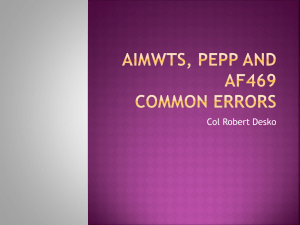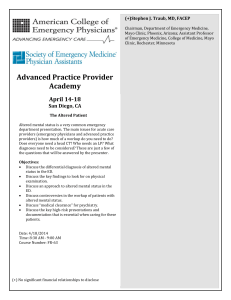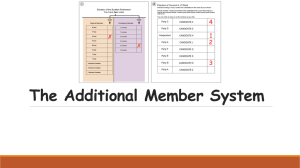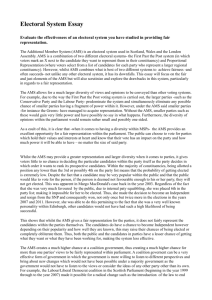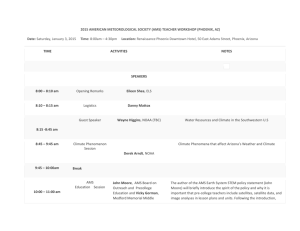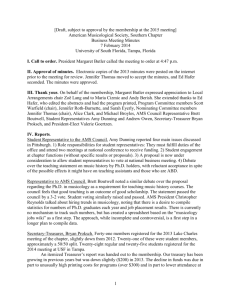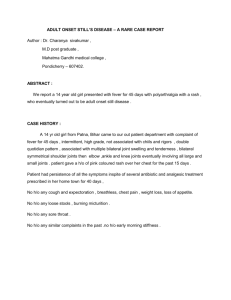AMS show notes (Word)
advertisement
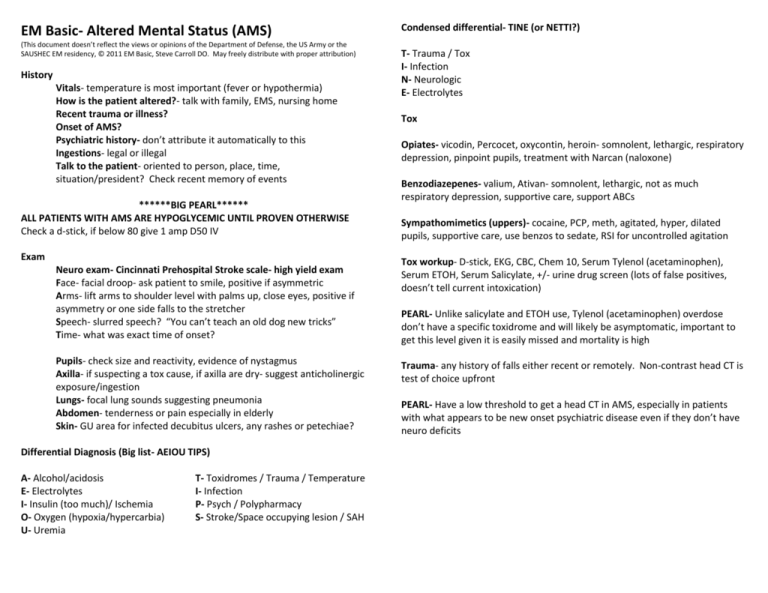
EM Basic- Altered Mental Status (AMS) (This document doesn’t reflect the views or opinions of the Department of Defense, the US Army or the SAUSHEC EM residency, © 2011 EM Basic, Steve Carroll DO. May freely distribute with proper attribution) History Vitals- temperature is most important (fever or hypothermia) How is the patient altered?- talk with family, EMS, nursing home Recent trauma or illness? Onset of AMS? Psychiatric history- don’t attribute it automatically to this Ingestions- legal or illegal Talk to the patient- oriented to person, place, time, situation/president? Check recent memory of events ******BIG PEARL****** ALL PATIENTS WITH AMS ARE HYPOGLYCEMIC UNTIL PROVEN OTHERWISE Check a d-stick, if below 80 give 1 amp D50 IV Exam Neuro exam- Cincinnati Prehospital Stroke scale- high yield exam Face- facial droop- ask patient to smile, positive if asymmetric Arms- lift arms to shoulder level with palms up, close eyes, positive if asymmetry or one side falls to the stretcher Speech- slurred speech? “You can’t teach an old dog new tricks” Time- what was exact time of onset? Pupils- check size and reactivity, evidence of nystagmus Axilla- if suspecting a tox cause, if axilla are dry- suggest anticholinergic exposure/ingestion Lungs- focal lung sounds suggesting pneumonia Abdomen- tenderness or pain especially in elderly Skin- GU area for infected decubitus ulcers, any rashes or petechiae? Differential Diagnosis (Big list- AEIOU TIPS) A- Alcohol/acidosis E- Electrolytes I- Insulin (too much)/ Ischemia O- Oxygen (hypoxia/hypercarbia) U- Uremia T- Toxidromes / Trauma / Temperature I- Infection P- Psych / Polypharmacy S- Stroke/Space occupying lesion / SAH Condensed differential- TINE (or NETTI?) T- Trauma / Tox I- Infection N- Neurologic E- Electrolytes Tox Opiates- vicodin, Percocet, oxycontin, heroin- somnolent, lethargic, respiratory depression, pinpoint pupils, treatment with Narcan (naloxone) Benzodiazepenes- valium, Ativan- somnolent, lethargic, not as much respiratory depression, supportive care, support ABCs Sympathomimetics (uppers)- cocaine, PCP, meth, agitated, hyper, dilated pupils, supportive care, use benzos to sedate, RSI for uncontrolled agitation Tox workup- D-stick, EKG, CBC, Chem 10, Serum Tylenol (acetaminophen), Serum ETOH, Serum Salicylate, +/- urine drug screen (lots of false positives, doesn’t tell current intoxication) PEARL- Unlike salicylate and ETOH use, Tylenol (acetaminophen) overdose don’t have a specific toxidrome and will likely be asymptomatic, important to get this level given it is easily missed and mortality is high Trauma- any history of falls either recent or remotely. Non-contrast head CT is test of choice upfront PEARL- Have a low threshold to get a head CT in AMS, especially in patients with what appears to be new onset psychiatric disease even if they don’t have neuro deficits Infection- look for fever, hypotension, tachycardia, try to ID a source, make sure to do a thorough skin and GU exam Electrolytes (selected situations) Glucose- if below 80, give 1 amp D50 IV and monitor response PEARL- If you can’t get d-stick quickly, just give D50, benefits >>>> risks PEARLS -The elderly and those on immunosuppression or steroids may not mount a fever in response to infection -UTIs cause lots of AMS in the elderly -Hypothermia in the setting of infection is especially concerning Infection workup- CBC, Chem 10, blood cultures x2, UA and urine culture, chest x-ray, LP if suspecting meningitis PEARL- You have several hours before antibiotics will affect culture results so give antibiotics early, especially if you suspect meningitis Hyponatremia -Asymptomatic- water restrict -Below 120 and seizing- hypertonic saline 3%, 2-3 cc/kg over 10 minutes and repeat until seizures stop -Below 120 but not seizing- consult appropriate reference for slow replacement with hypertonic saline Hyperkalemia Broad spectrum antibiotics Zosyn (piperacillin/tazobactam)- 3.375 or 4.5 grams IV Vancomycin- 15-20 mg/kg, usual dose 1 gram IV (many guidelines suggest 1st dose be 2 grams IV for faster therapeutic levels) Ceftriaxone- (in some areas better than Zosyn for urinary pathogens) 1 gram IV, 2 grams IV if suspecting meningitis (along with Vancomycin) -EKG changes (peaked T waves, QRS widening)- immediately give 1 amp Calcium gluconate IV to stabilize cardiac membrane and prevent arrhythmias -Other treatments- insulin/glucose, furosemide, albuterol, dialysis Neurologic ****D-STICK**** EKG CBC Chem 10 UA/Urine Culture Blood culture x2 VBG with lactate Seizures- make sure they aren’t from hypoglycemia first, -Must have some sort of post-ictal state afterwards with AMS that slowly or quickly improves -May be intermittently agitated and then somnolent -If they have a seizure history and they didn’t hit head, support ABCs and you can allow to wake up and try to find cause (usually missed medication doses) -If new onset seizure, trauma, or other concerns, do appropriate workup Stroke- New onset focal neuro deficits -D-stick first, hypoglycemia can mimic a stroke -Address ABCs then immediately get a non-contrast head CT -Don’t delay on the head CT, activate ED stroke protocol -If no intracranial bleed and within 3 hours of onset, can give TPA if no contraindications -Get a checklist of all contraindications and go through each one -Certain patients qualify for 4.5 hour time window General AMS workup (add or subtract testing as appropriate for clinical situation) Urine Drug Screen (with caution) Serum acetaminophen (Tylenol) level Serum ETOH level Serum salicylate level LP if suspecting meningitis Chest x-ray Non-contrast head CT MAJOR POINTS: 1) All patients with AMS are hypoglycemic until proven otherwise 2) Broad categories of AMS- TINE- Trauma/Tox, Infection, Neuro/Electrolytes 3) Have a low threshold for non-contrast head CT 4) Get a good neuro exam- quickest is Cincinnati Prehospital Stroke ScaleFace, Arms, Speech, Time Contact- steve@embasic.org
